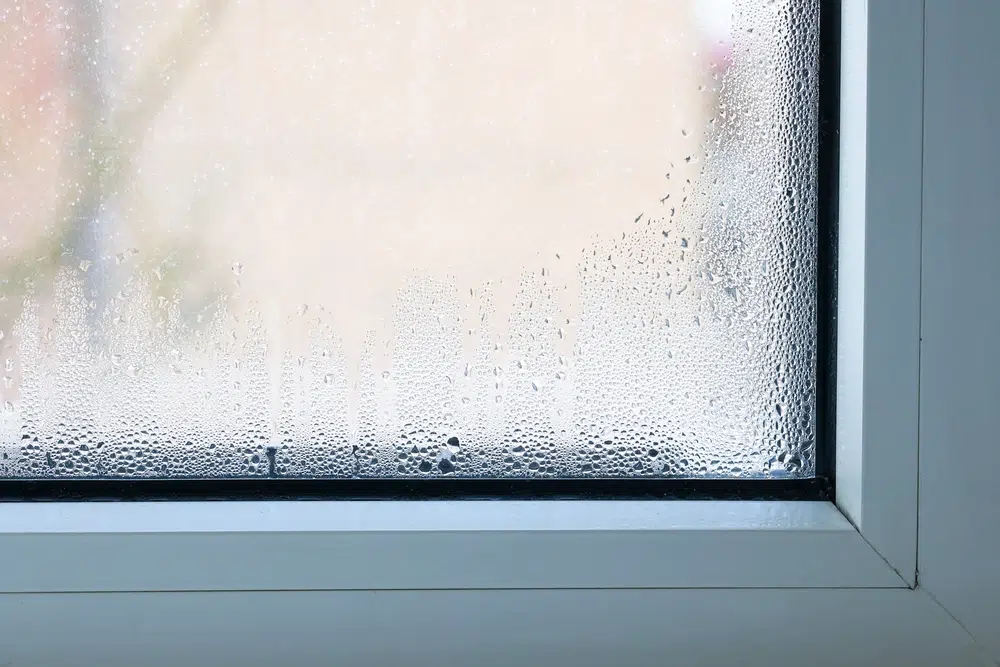How to stop condensation: The ultimate guide

If you’re looking for advice on how to stop condensation from affecting your property, we’ve got good news. Compared with other damp problems, it’s easy to sort out if you catch it in time.
Condensation collects as water droplets when warm air meets cold surfaces. There are a few different conditions that pave the way for condensation accumulation. Humid air and winter temperatures both make your home more susceptible to condensation buildup.
In this article, we’ll discuss:
How excess condensation can affect you and your property.
Methods to deal with condensation in your home as it occurs.
How to prevent accumulation in the future.
Read on!
The potential effects of condensation on your property
A few water droplets on your window will likely not cause an issue for your property. The danger comes when those drops accumulate and turn into damp and mould.
Damp issues in your home can:
Damage your property and furniture. If not properly taken care of, condensation can lead to mould and mildew. This can cause all sorts of issues.
You may notice that your paint and wallpaper are coming off the walls or that black mould is accumulating near your windows. When this happens, it can damage your belongings and furniture and even lead to structural damage if it gets through the walls and floors.
Negatively affect your health. Mould spores multiply quickly on damp surfaces. This can result in respiratory conditions and allergic reactions like sneezing and coughing.
So serious is this issue that the government now mandates that:
“landlords must ensure that the accommodation they provide is free from serious hazards, including damp and mould.”
Because it is your responsibility to deal with damp issues in your home, insurance typically doesn’t cover the cost of structural repairs related to it. Damp damage to your furniture and other belongings is usually not covered either.
Understanding how condensation can lead to damp and what you can do about it is an important part of protecting your home, whether you’re a renter or an owner.
We’ll take you through the details.
Why is my house so full of condensation?
There are a few reasons why condensation may be appearing on the surfaces in your home.
Condensation accumulation is particularly common during the winter months. When your heating system kicks into gear in the colder times of the day (particularly early mornings and late evenings), the warm air meets with cold surfaces.
At this point, the moisture in the air turns to liquid. In scientific terms, it means it’s gone below the dew point and will therefore condense on surfaces.
The breath we breathe out is full of moisture. When it doesn’t have a place to escape, it builds up in your home as excess moisture. This can make our homes breeding grounds for condensation, particularly if they are not well-ventilated and the temperature is not kept constant.
Why do my windows have condensation on the inside?
The insides of windows are a common place for condensation to form, mainly because they’re a meeting point between hot (inside) and cold (outside) air.
To stop this from happening, you may need to upgrade your insulation to prevent heat from escaping and keep the temperature more consistent in your home. While this may sound like a big job, it’s worth it in the long run as it will help you prevent moisture buildup and even help you save on your heating bills.
All sorts of other factors can also lead to condensation accumulation, including hanging washing inside and cooking.
But there’s hope! We’ll take you through the steps.
How do you stop excessive condensation?
1. Deal with it promptly
Like all problems with damp, excess condensation is an issue best dealt with as soon as you notice it. By clearing condensation on the inside of your windows promptly, you’ll save yourself a lot of potential hassle down the line.
Here’s how:
Wipe condensation off windows. When you see it appear, clean it off with water, soap and a cloth. If it has already turned into mould (ie. you can see black spots), wear a mask and gloves to do the job.
Clear moisture off cold surfaces. Moisture from cooking and showering can quickly turn into mould. If you don’t have an extractor fan — or you do and you’d like to be extra diligent — wipe off cold surfaces as soon as you’ve finished using them.
2. Air it out
Ventilation is your best friend to reduce condensation in your home. Keeping the windows open is a good idea in mid-summer. Sadly this is not possible all year round — and particularly not in winter when condensation is most likely to occur.
Here are some other steps to take:
Open your windows. Of course, there are some times in the year when this is the last thing you want to do. If it’s not possible to open your windows, install trickle vents on them. They allow a tiny amount of ventilation at all times.
Keep extractor fans on. The goal here is to remove hot, moist air before it has a chance to cause a condensation issue. This is particularly important when showering and cooking.
Get a dehumidifier. If you’ve had the opposite problem of having to contend with very dry air, you may be familiar with the trusty humidifier. A dehumidifier gets rid of excess moisture in the air. This can help you prevent a buildup of condensation before it happens.
Dehumidifiers come in different models according designed to deal with different amounts of space. They vary in price from about £35 to £150.
And if you want to opt for a really clever life hack, some people are finding a dehumidifying solution in a sock full of cat litter. This is proving to be a particularly effective way to absorb moisture in cars. Worth a shot!
Ensure there’s a gap between the wall and your furniture. In winter, the exterior of your walls will be colder than the interior. If your furniture is right up against the wall, the cold surface of the exterior wall could collide with moist air, causing condensation.
Spaces that are more difficult to see and access can be breeding grounds for damp and mould issues. By keeping a space between your wardrobe or sofa and the wall, you’ll create a passage for air to circulate the room.
Allow for proper ventilation around your washing machine and tumble dryers. Ensure that your washing machine is at least 2 and a half centimetres away from the wall. The same goes for your tumble dryer. The ventilation will make it more difficult for damp to build up on your walls.
Tumble dryers need some special attention when it comes to preventing condensation.
Vented tumble dryers, have a ventilation pipe that will feed moist air out of the house.
Condenser dryers don’t need a ventilation pipe — but they can cause condensation. The dryer may heat the surrounding air which could come into contact with colder surfaces and lead to condensation.
Condenser dryers remove the moisture from your clothes into what’s called a condensation tank. To avoid issues, it’s important to empty the condensation tank often.
Keep your dryer in a well-ventilated area and ensure it is well maintained.
3. Put preventative measures in place
Other than keeping your home well-ventilated, there are other measures you can try to keep condensation on windows from causing a problem in your home.
Implement the following strategies:
Put lids on your pots and pans when cooking. The goal is to decrease the amount of water released into the air when you boil water or pan-fry your favourite dish.
Keep the bathroom and kitchen doors closed. These are the two rooms in our homes that typically produce the most moisture. When hot, moist air travels into colder rooms, you may find yourself with condensation accumulation.
Dry your clothes outside. While this is not always possible, if you have the option, it’s best to hang your clothes outside to dry. Moisture buildup from wet clothes can add to humidity in the air.
If you need to dry your clothes indoors, the bathroom is a good place to do this. Keep the doors closed so the moisture doesn’t escape and keep the extractor fan on.
Don’t use portable gas heaters indoors. These heaters give off a lot of moisture into the air, creating the right conditions for condensation.
Ventilate pet and plant areas. Pets (and plants!) are part of our families. Some of their activities can put excess moisture in the air.
If you notice condensation build-up near your plants, it may be best to pop them outside. Similarly, it may be worth putting a cover on the fish tank if you notice excess moisture developing.
4. Check the insulation and heating in your home
If your home is properly protected from the cold, you are less likely to experience a condensation problem. There are two key ways to ensure this is the case:
Keep your home well-heated. An effective heating system will help maintain a relatively constant temperature in your home. (Remember, it’s those extremes meeting up that can cause the problem.)
Check to see that your heating system is working well.
Ensure your home is well insulated. Insulation prevents heat from flowing meaning it’s easier to keep a more consistent temperature.
While you may have to spend a bit of money to get your heating system up to scratch or your house properly ventilated, it’s worth it in the long run. The reality is that problems with damp can land up being very costly in the future. Best to sort it out asap.
To sum up
Condensation itself is not necessarily an issue for your home, but it can cause one.
If you have excessive condensation build-up, it can lead to problems with damp and mould. This can be dangerous for both your health and your property.
To prevent condensation from accumulating:
Clean droplets as soon as you notice them.
Ensure that your home is properly ventilated.
Put other preventative measures in place, such as putting lids on pots when you cook and not drying your clothes indoors whenever possible.
Check the heating system and insulation in your home.
Because you are responsible for preventing damp and mould in your home, it’s unlikely that insurance will cover anything damp-related.
If you’d like to talk through all things home cover, give us a shout.
Also read:




